September 11, 2018
Let Us Rise Up and Rebuild…Again (Rosh Hashanah 5779/2018)
Peter J. Rubinstein
Watch our sermon above or on Youtube, listen on Apple Podcasts and Spotify.
Click here to listen to or download audio only (MP3)
For many of us in this sanctuary it was 20 years and two weeks ago that a moment froze in memory. We remember where we were when we heard the news or as we watched smoke rise from this building and flames lap at the underside of its roof. Our sanctuary was being destroyed by fire.
For those of you who were members on August 28th, 1998 this 20th anniversary of the fire should not only be a time of memory but also a moment of celebration and thanksgiving for this exquisite sanctuary which you helped rebuild.
I also know that for many of you here today this anniversary is simply a matter of history which you may have witnessed as non-members. Now you are fully a part of our story. No matter when you joined you have brought energy, imagination and ideas that support the mission and purpose of this incredible synagogue which all of us are building together.
And what we are building now, this unequaled congregation, is not only about the past but as much about the present and future because of the extraordinary clergy we have now, led by my incomparable successor, our Senior Rabbi Angela Buchdahl with the unswerving support of Rabbis Salth, Lorge and Kolin and our Senior Cantor Dan Mutlu and Cantor Cadrain. I extend special gratitude on all our behalf to Cantor Mutlu for his efforts in spearheading the production of this glorious Mahzor along with our clergy team. These are clergy, whom along with amazing lay leaders. continue to lead us to greatness.
This sermon is both a retelling and a re-formation of the sermon I delivered from the pulpit in the Park Avenue Armory on Rosh Hashanah as for the first time we gathered as a single congregation just three weeks after the fire. I believe the message that drove us then has powerful implications for today.
Let me begin by recounting and show you a bit of what happened as we prepared to begin Shabbat evening services on Friday, August 28th, 1998, an event which immediately became a national story and beyond.
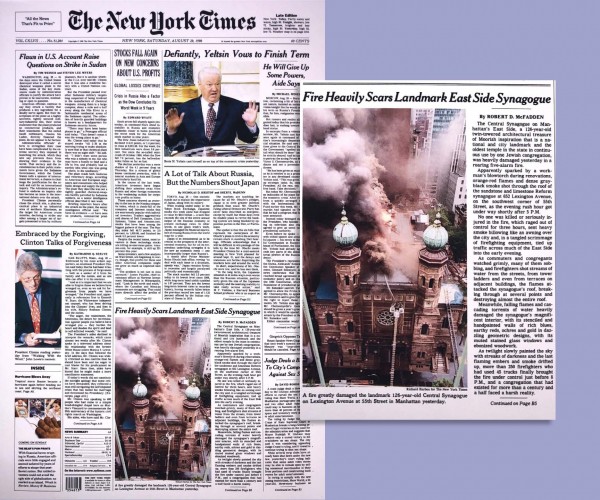
1. We were in the last days of the third summer long project to update the sanctuary building. Instead of using hot tar as was intended to affix the flashing between the balcony roof and the clerestory wall the workers used a blow torch which ignited the almost 130 old wood lathing between the interior walls and the exterior stonework. The fire began in the northeastern section of that roof and rapidly spread forward between the roof and the sanctuary ceiling below in a space which separates the two.
2. Due to the professionalism, courage, sensitivity and tenacity of the fire fighters of the 8th Battalion, who cannot be thanked enough, the fire was primarily contained to the center roof area which is above us.
3. They fought the fire through the top tier of clerestory windows and broke only enough of the center pane of the rose window to ascertain that there would be no advantage to fighting the blaze from there. Then they protected that window and all the other windows on the main and balcony floors.
4. As a result of the fire the main center section roof was totally destroyed and collapsed.
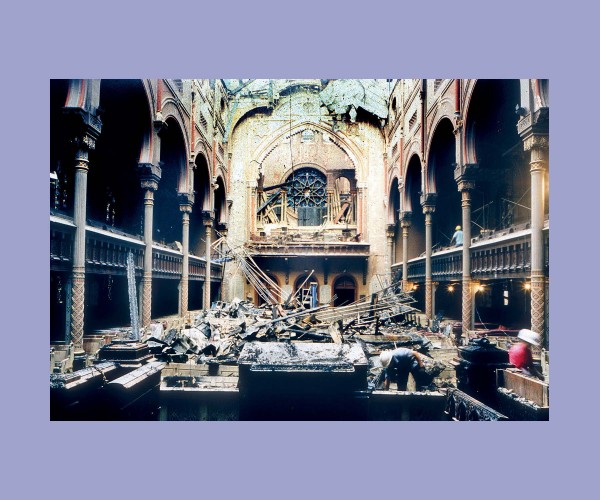
5. Only one of the triangular heavy beam trusses that had held the roof up collapsed and pierced the floor of this sanctuary stopping when it hit the bottom of the floor below.
6. The devastation in the center of the sanctuary was complete. The pews were set on fire by the falling roof.
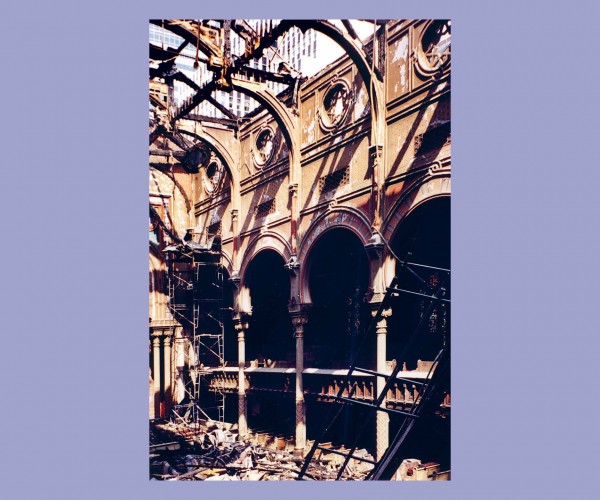
7. The choir loft and the organ were completely demolished.
8. The pulpit was damaged. But this reading table remained, scarred but intact.
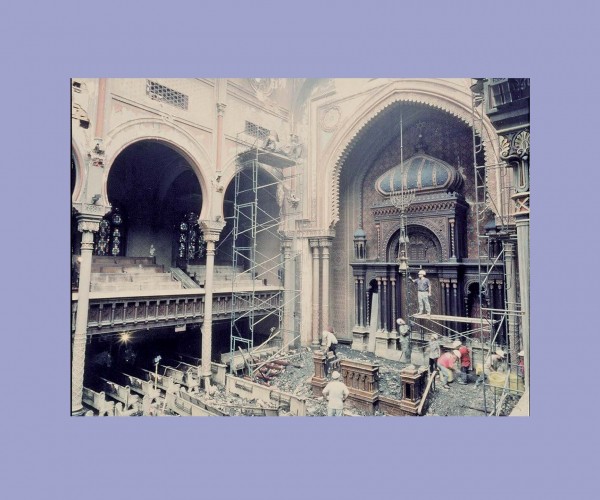
9. Practically all our prayer books were lost. We buried them in three graves 15 feet deep.
10. The Ark was damaged by the searing heat and water not from flames. The Torah scrolls had been removed for the summer and the single Torah remaining in a showcase in the lobby was removed when the fire first began.
11. And of greatest significance the Ner Tamid, the Eternal Light was still in place and the Mezuzah on the door post of the center door was undamaged and remained there throughout the reconstruction as it still does. For me the survival of the Mezuzah and the Ner Tamid was a mystical symbol that our building should be rebuilt. Within hours after the fire, under the leadership of our congregational presidents Martin Klein and Sam Wasserman, who lead us during that era we decided to stay and rebuild here in the center of our city.
12. ABOVE ALL NO LIFE WAS LOST. THERE WERE NO SERIOUS INJURIES. We had suffered a deep trauma, but we never described what happened as a tragedy.
Unlike the images of crowds cheering the burning of synagogues on Kristallnacht almost 80 years ago the crowds who witnessed our sanctuary in flames on that Shabbat evening stood in stunned silence. Many of them cried along with our members.
And in keeping with Jewish history and tradition, even as the fire burned, our Associate Rabbis Josh Davidson and Sarah Reines lead Shabbat Services in Beir Chapel.
Our mayor Rudy Giuliani came twice that evening and stood with us in a circle alongside political adversaries as we held hands in prayer when the flames had finally been extinguished. Cardinal John O’Connor stood by my side and acted as our liaison to the Fire Department. My clergy friends stood with me to help speak to the news media and to comfort our members. Within days Governor Pataki, the Archbishop of Canterbury, the CEOs of corporations in our neighborhood all came to be with us.
The pain of our members was evident and unmistakable. But why were so many others in tears? It was not their building. They were suffering no apparent loss, no significant upheaval.
I thought about that a great deal as letters of support and condolence poured in from Jew and non-Jew, from throughout the city and the nation and the world. Most arrived with donations, large and small. Every note had a single theme- that they understood. They felt our distress. The devastation of our building was a universal experience, not because a building had been harmed, but because it was in particular a sanctuary, that had been struck.
The destruction of a sanctuary evokes powerful feelings of vulnerability. Sanctuaries are intended to be harbors of safety and holiness lifting us up from the mundane and providing us a platform for the speaking and rehearsal of our highest values.
If our grand and historic house of worship was not safe from life’s vagaries, then what was safe? Sadly, we and all those who have been and who became our friends confronted a reality which is an underlying premise of these Days of Awe. Life is precious because it is vulnerable. What we thought was an impenetrable building suffered harm. How much more are we and our lives defenseless against malevolent forces such as the terrorism and mass shootings in the last two decades. Sickness, tragedy, loss- they are inescapable portions of the human condition.
Wisely, as we comprehend these traumas, we commit ourselves to relish even more the blessed occasions of our lives- the single happiness of fulfilled moments, the celebration of new life, of life itself, and the wonder of love and honor and faith, those eternal verities upon which civilization has built nobility. A birth of one baby overlays the patina of sorrow.
We Jews search for meaning in the vicissitudes which strike us, but we eventually come to comprehend that there are no answers, no explanations for the harms that befall us. On these holidays we forfeit comprehension with a heartfelt prayer:
Let us proclaim the sacred power of this day;
In truth, O God, You are Judge and Arbiter, Counsel and Witness.
You open the book of our days, and what is written there proclaims itself, for it bears the signature of every human being.
We cannot control the hand we are dealt, but we can absolutely decide on how to play that hand.
That was the venture before us 20 years ago. It was the challenge of integrating the trauma we had suffered into passionate new strength, discovering anew the meaning of synagogue and community and all the while knowing that there was no obstacle great enough, no chasm wide enough, no wall high enough to defeat us.
We hearkened to Nehemiah’s plea to the people of Jerusalem when he first witnessed the collapsed walls of that city which he described as “broken down and the gates thereof were consumed with fire”. (2:13) In desperation Nehemiah implored the people “Let us rise up and build” to which they vowed “Nakum oo-va-nee-nu” “let us rise up and rebuild” (2.18) Those words became our rallying commitment: We will rise up and rebuild”.
The promise was emblazoned on the scaffolding around the building
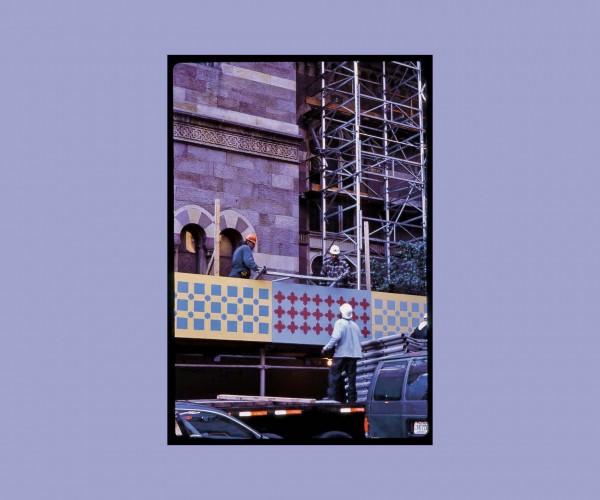
and as a tagline on our stationary and in every publication and communication of this congregation. It became our banner of hope and of purpose. They were the words which prodded us to our mission and vision.
And why did we rebuild? While the soul of this congregation is in us, this sanctuary emblemizes our soul and gives us the place from which to speak and gain strength. Our voices emerge from this Sanctuary. We are not our own little corner of the world. Our city and our nation need us. From our sanctuary emerges a helping hand for poor people and all people who need help. From our sanctuary comes an active response to injustice with a message of hope. From this sanctuary flows a moral voice to shape our society and our nation. From our sanctuary flows Jewish life and survival. In this sanctuary are the answers to the poet Adrienne Rich’s questions “Where are we moored? Where are the bindings?”
Our answer is we are moored here! We are bound here to a precious eternal message that pays homage to the best of humanity and of Jewish life.
Twenty years ago, we knew that while we had suffered a grave injury, no dagger had gone through our heart and we rebuilt, all of us together. Each one of us left an imprint on this building by helping paint the stenciling which adorns our walls.
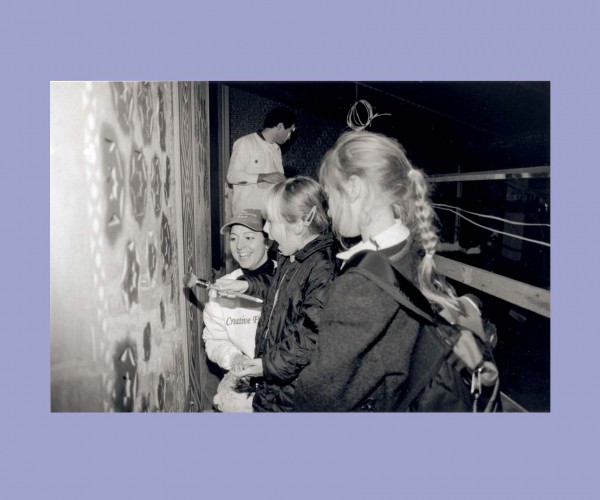
But I assure you none of this would have happened without the extraordinary vision, boundless energy, superlative support and guidance of the people noted on Page 55 of this glorious Mahzor. (Let us take a moment to glance at their names.) They were the ones who with quiet assurance did the heavy lifting and without any desire of glory radiated glory onto this congregation. (I also acknowledge that are presently only two members of our staff who were on staff in 1998 as we slogged through those difficult times.) These are the people to whom our gratitude is due for this home of ours.
Our house had been damaged but with these people at the fore we knew that there would be that glorious day when we would return to this sanctuary and make it our home again and we did on September 9th, 2001.
As we promised we threw open the doors and returned our Torah scrolls to their place in the ark.
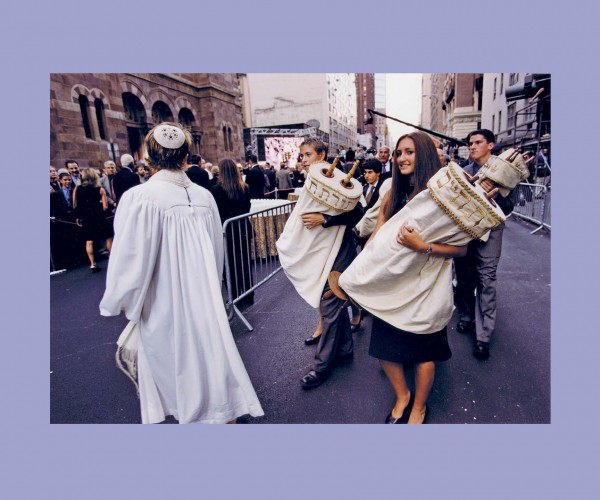
Just two days before 9/11, this exact date 17 years ago, we rededicated this sanctuary and rejoiced, and the city and state rejoiced with us.
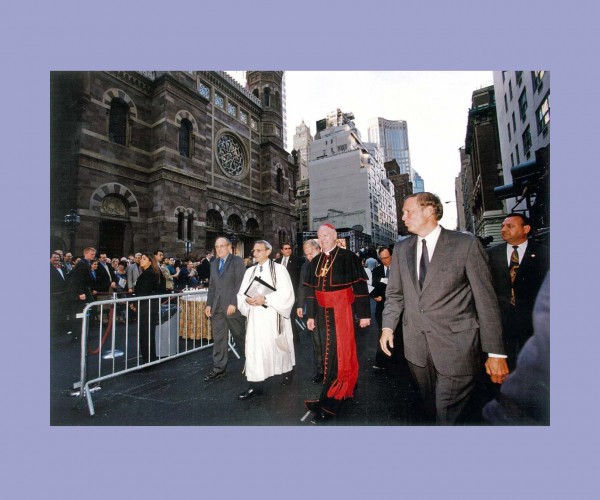
But what we didn’t fully comprehend 20 years ago was a task similar to the story we read in Nehemiah. In his day, Nechemya was concerned not only about a physical rebuilding of Jerusalem but also about the resuscitation of a society that was at odds with itself, a leadership with intolerant opposing parties creating social chaos that was more focused on maintaining power than serving the needs of the people.
Jerusalem was a city in which partisan truths vilified the eternal teachings of our people’s wisdom. We are a congregation that rebuilt our sanctuary. But we are also a congregation which takes responsibility for the world outside these rebuilt walls.
With reverence, perseverance and unflagging vision and purpose we aim to continue our mission to use this place as a light to the nations and as a pulpit to speak about and work towards the embodiment of justice, compassion, acceptance, forgiveness and peace.
On this 20th anniversary of the destruction of our sanctuary and on this dawn of this New Year I yearn that we unfurl again the banner that led us once before to greater heights and magnificence: “Nakum oo-va-nee-nu” “let us again rise up and rebuild”.
Our building is done. But our lives, our people’s future, and our society are not.
We have more to do. These three challenges might be foremost. They are matters demanding great fortitude from us.
1- Our Jewish Future:
It is not OK that our children on college campuses have all but been abandoned by liberal Jewish institutions to help them refine and empower their Jewish identity. We need to put our collective shoulders to the wheel and help raise our children and grandchildren to embrace their Jewish future, the values and virtues of our people and the mission of being a light to the nations.
I’m extraordinarily proud and grateful that this congregation has used the money given in my honor to the Fund for the Renaissance of Reform Judaism to support HUC-JIR, our seminary, and Hillel working together to initiate for the first time a program for finding, training and placing the best of our rabbis and educators on college campuses.
Despite the challenges of modernity, we each have to be deliberate in raising our children and grandchildren to embrace their Jewish Identity and to see themselves as the seed of a Jewish future. It is a continuing mission for each of us and all of us together. Let us rise up and ensure our Jewish future.
2) Israel:
We need to rebuild our relationship to, and rekindle our love for, the State of Israel. It is not OK that we abandon Israel. One has a right to abhor (or love) the policies of Israel’s government and leaders as much as we have a right to do the same in this nation. But just as our patriotism to the US should never be in question, neither should our love and support for Israel ever be in doubt. To paraphrase Bret Stephens article on the occasion of that nation’s 70th anniversary “Israel is not our vanity. It is our safeguard.”
Let’s take seriously Britain’s former Chief Rabbi Jonathan Sacks’ warning last week that for the first time in British Jewry’s history British Jews question whether it is safe to raise their children there. They are thinking about leaving.
And in the rest of Europe, the 1000 reported Anti-Semitic acts in Berlin alone, the growth of rabid right-wing parties with Nazi roots and incipient, if not full-blown anti-Semitic indictments and Nazi salutes should put us on notice. It may not happen here, but it will happen somewhere that entire Jewish populations will need to seek refuge and Israel alone would take them in. We have every right to condemn vehemently Israel policies on civil marriage, non-Orthodox Jews and non-Jewish minorities and the LGBTQ community, but as Ronald Lauder put it poignantly in his New York Times op-ed piece, let’s do it as a member of a loving family. Let us unabashedly stand by the existence and well-being of the state of Israel. Let us Rise up and Rebuild our relationship with that beloved country.
3) Our Nation
Lastly, let us take our civic responsibility seriously. We have a nation to rebuild, chasms to bridge, virtues to embody and principles to uphold. Whatever your political or partisan point of view we can agree that the divides in this nation are becoming more ominous, toxic, rancorous and sadly, even murderous and it is not OK. And it certainly not Ok that whether out of frustration or exhaustion we stay afield from the process which supports our democratic underpinnings.
Just over a week ago we heard exquisite testimony to John McCain, a man whom many of us knew initially as a released Prisoner-of-War. To the best of any person’s ability McCain maintained his integrity and vows and forged forward to reinvent himself in the world of politics. He focused himself to find solutions rather than to find fault. He believed in sacrifice and fortitude, pillars upon which America’s greatness is founded.
No one could have lived more fully to the aspiration of “Let us Rise up and Rebuild” than John McCain. His memory calls upon all of us to do what we can do with fortitude by voting, supporting, forgiving and urging our nation to the best it can be. And as much as anything we need to bridge apparently impassable barriers and engage in civil conversation that permits all of us on all sides to listen and speak to each other.
As this congregation needed to do in 1998 we all have work to do in our own lives now: to transform a struggle into an aspiration, destruction into creation, despair into hope.
We rebuilt our sanctuary by each of us adding our imprint to the stenciling on these walls which surround us. We built this congregation each one of us with the grandeur of our vision, the passion of our souls and the longing of our hearts.
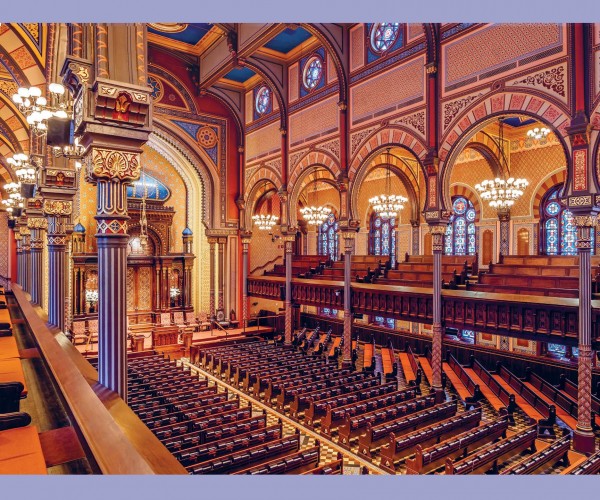
But the need before us remains. We should do no less than we did for this congregation to nourish the future of Jewish life; to reaffirm and rebuild our loving, if not critical relationship with Israel; and to heal and inspire our nation to the greatness we think it deserves. It will take each of us and all of us together to make a difference. The hero of the Akedah which we read this morning is the angel. If the angel had called to Abraham one moment too late the dagger in Abraham’s hand would have gone through Isaac’s heart and our story would have ended.
We have work to do this year. We cannot wait. Let us move on with strength and powerful driving conviction. Then we will sing a song of renewal and thanksgiving to God.
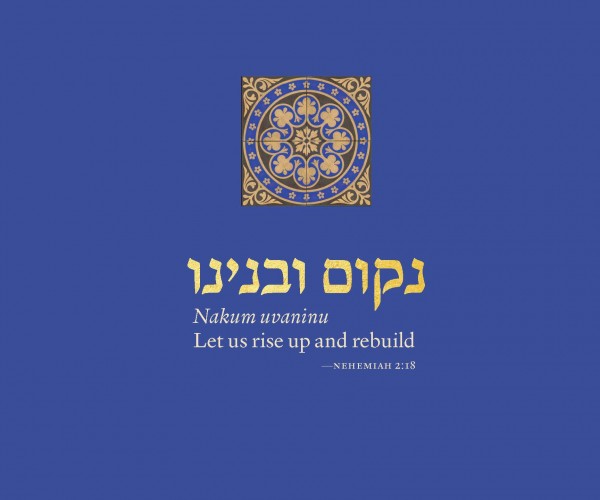
Nakum oo-va-niynu- Let us rise up and rebuild. May we do it well and quickly get on with it. Amen.